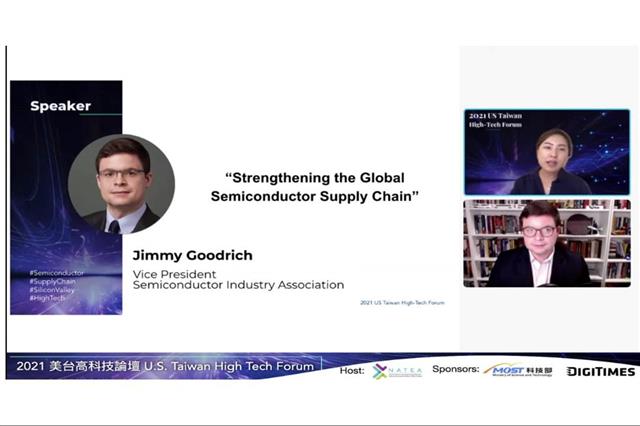A resilient semiconductor supply chain is pivotal to the global economy, and the world has learned it the hard way over the past two years. Industry leaders who spoke on the US-Taiwan High-Tech Forum (UTHTF) hosted by the North America Taiwanese Engineering Association (NATEA) contributed their experience and wisdom on how to create a sound and resilient supply chain amid opportunities and challenges in the post-pandemic era.
To celebrate its 30th anniversary, NATEA invited industrial leaders including Young Liu, chairman of Foxconn, Jimmy Goodrich, VP of Semiconductor Industry Association (SIA), Brian Shieh, VP Applied Materials and DIGITIMES president Colley Hwang to speak on the first day of UTHTF.
Liu noted that semiconductor is closely knitted into daily life, from such applications as online banking, transportation, medical care to the military. Semiconductors have also become very powerful, enabling deep learning algorithms, handling enormous amounts of data on the cloud, and letting AI become intelligent enough to work, said Liu.
And the pandemic over the past two years has sparked huge demand for semiconductors, said the Foxconn chairman.
Goodrich said the inherently global semiconductor industry, with a market value of US$460 billion and US$1.7 trillion in international trade in 2019, has four major challenges ahead, namely, "geo-political tension, trade restriction and tech-nationalism," "rising cost of manufacturing and design innovations," "global incentives and subsidies," and the China challenge.
"We believe it is important to strengthen the US semiconductor manufacturing base in order to increase the resilience of the supply chain,… but the perception that the US is trying to be self-sufficient in semiconductors and re-shore the supply chains, that is absolutely false," said Goodrich, stressing on the need of deeper global collaboration among all key players to solve the challenges and ensure an open and healthy semiconductor ecosystem.
He added it is impossible for any country trying to be self-sufficient, even for the United States. Strong interdependence between the US and Taiwan is demonstrated in their complementary strengths in the semiconductor value chain: US has a leading position in high-value core IP and R&D-intensive design, software, logic and analog chips, and owns 41% of the semiconductor manufacturing equipment market, while Taiwan is strong in high-volume, customized and advanced foundry fabrication and IC packaging and testing.
China has committed more than US$190 billion of investment to build 110 new fabs since 2014, and revenues in IC design space in China has enjoyed a 20-30% compound annual growth, with more than 20,000 new companies entering the semiconductor space. "Though its ambitious self-sufficient goals are far from being accomplished any time soon, in 5 to 10 years, it will be a significant force to reckon with," Goodridge said. In fact, China firms in 2019 had already outpaced Taiwanese firms in terms of their global fabless market share.
Supply chains in transformation
Geopolitical tension, the US-China Trade War and the COVID-19 pandemic over the past 2 years also accelerated the reposition of supply chains. But one thing is certain: no one company or country can dominate all aspects of the semiconductor supply chain, and it will be even more diversified in the future.
Colley Hwang, president of DIGITIMES, pointed out that creating new market demand is a good way to help build a more resilient ecosystem of semiconductors.
"There are more than 650 million people in Southeast Asia and nearly 2 billion in South Asia, including India, Pakistan, Bangladesh, Sri Lanka, etc." Huang said, if Taiwan can help these countries build their own manufacturing industries and distributed manufacturing supply chain in the future, Taiwan can serve an important role to meet the needs not only for China, the United States, but also the emerging countries in Asia.
Hwang is basically saying that helping ASEAN and South Asian countries to build up their manufacturing capabilities will create a new gigantic market for semiconductor products, as semiconductors are becoming ubiquitous in all industries, including robotics, consumer electronics, transportation, healthcare, etc.
Currently, China is still the largest consuming market for semiconductors while also the main production site for personal computers, taking up almost 60% of the IC market. However, some of those consumptions are from multinational companies which assemble products in China and ship them overseas for end users. In terms of the economic scale, China's influence is still huge. According to a DIGITIMES survey, by 2023, 73% of the world's traditional LCD panels will be manufactured in China, while Taiwan takes up 21%, but the latter will be application-driven and product-driven.
But as time goes by, Southeast Asia and South Asia will start to take away some part of that gigantic pie of manufacturing from China. "Three years from now, 30% of laptops will be produced in Vietnam, while 15% of capacity will move to Thailand; Now Pegatron, Wistron and Foxconn are building new factories in India, serving international companies such as Apple, Lenovo, and even Acer, in ASEAN and Indian markets."
Many international companies such as Western Digital have set up IC packaging and testing lines in Malaysia, while Japan's ROHM has separate lines in the Philippines and Thailand, respectively.
"We will have new supply chains unlike anything else in the past," said Hwang, citing Young Liu's model of building MIH as an open platform for EV supply chains to break down the Tier 1-2-3 barriers that prevented new entrants from tapping the ecosystem of the original equipment auto giants.
What is interesting is that carmakers such as Tesla, Volkswagen and consumer electronics OEMs such as Amazon, Apple, Google, and Microsoft are now designing their own system-on-a-chip (SoC) in order to differentiate from their competitors. They are able to do so not just because they have great talents and invested heavily in research and development, but also because of the super cost-efficient and high-quality foundry services provided by companies such as TSMC.
"When old ways of doing things are broken down, the best way is for us is to work together to build new ways that work," said Hwang.



